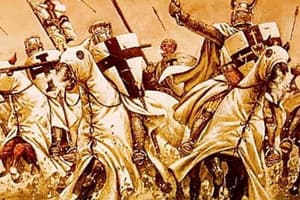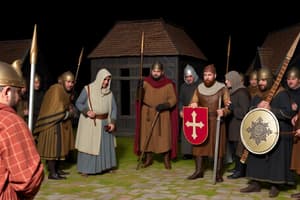Podcast
Questions and Answers
What was one significant consequence of the Crusades for the feudal system in Europe?
What was one significant consequence of the Crusades for the feudal system in Europe?
- Peasants became less dependent on feudal lords.
- Many nobles sold land and freed serfs to finance their expeditions. (correct)
- The Church decreased its influence on political matters.
- Nobles gained more land and power due to successful campaigns.
Which technological innovation contributed significantly to agricultural efficiency in Medieval Europe?
Which technological innovation contributed significantly to agricultural efficiency in Medieval Europe?
- Windmills
- Irrigation Systems
- Crop Rotation Method
- The Carruca (correct)
What motivated the Byzantine Emperor Alexios I to appeal for help during the Crusades?
What motivated the Byzantine Emperor Alexios I to appeal for help during the Crusades?
- To expand the Byzantine Empire into new territories.
- To spread Christianity across the Eastern Europe.
- To secure trade routes for his merchants.
- To defend against the Muslim Seljuk Turks threatening Constantinople. (correct)
How did the warming period from 1000 to 1300 CE impact Medieval European society?
How did the warming period from 1000 to 1300 CE impact Medieval European society?
Which of the following best describes the role of the Catholic Church in Medieval European society?
Which of the following best describes the role of the Catholic Church in Medieval European society?
What was one of the primary motivations for individuals to join the First Crusade?
What was one of the primary motivations for individuals to join the First Crusade?
What was one outcome of the agricultural advancements in Medieval Europe?
What was one outcome of the agricultural advancements in Medieval Europe?
Which statement accurately characterizes the social structure in Medieval Europe?
Which statement accurately characterizes the social structure in Medieval Europe?
What was the main consequence of the Siege of Jerusalem concerning Christian-Muslim relations?
What was the main consequence of the Siege of Jerusalem concerning Christian-Muslim relations?
Which document described the aftermath of the siege focusing on the emotional distress among Muslims?
Which document described the aftermath of the siege focusing on the emotional distress among Muslims?
What triggered the Second Crusade in 1147?
What triggered the Second Crusade in 1147?
What was a significant economic effect of the First Crusade?
What was a significant economic effect of the First Crusade?
Which document shared a Christian Crusader perspective and detailed the indiscriminate killings during the siege?
Which document shared a Christian Crusader perspective and detailed the indiscriminate killings during the siege?
Which of the following best describes the outcome of the Third Crusade?
Which of the following best describes the outcome of the Third Crusade?
What was a notable action taken during the Fourth Crusade?
What was a notable action taken during the Fourth Crusade?
What was one tragic outcome of the Children's Crusade in 1212?
What was one tragic outcome of the Children's Crusade in 1212?
Flashcards are hidden until you start studying
Study Notes
Introduction to the Crusades
- The Crusades were religious wars initiated by European Christians aiming to reclaim the Holy Land from Muslim control.
- They spanned from the late 11th century to the late 13th century, significantly affecting societies in Europe and the Middle East.
Feudalism in Medieval Europe
Origins of Feudalism
- Emerged in response to political fragmentation after the fall of the Western Roman Empire and external threats from invasions, notably by Vikings.
- Feudalism established a hierarchy where lords provided protection and land (fiefs) to vassals in exchange for military service.
Role in Society
- The Catholic Church wielded substantial influence, often surpassing secular leaders like kings.
- Society was structured into distinct classes: nobles, knights, clergy, and peasants (serfs).
- During the Crusades, many nobles sold land or freed serfs to finance their involvement, leading to a decline in feudal power.
Peasants, Trade, and Cities
Agricultural Advancements
- Population increased due to improved food supply from agricultural innovations.
- Key technological advancements included:
- Three-field crop rotation increasing yield.
- Carruca, a heavy plow that enhanced productivity.
- A warming period from 1000-1300 CE contributed to agricultural benefits.
Urbanization and Trade
- Migration to urban areas led to the pursuit of trades distinct from agriculture.
- Establishment of markets and trade centers, often in revitalized Roman cities.
- Popular trade goods included spices, silk, gold, and silver, with Italian port cities (Venice, Genoa, Pisa) becoming major trade hubs.
The First Crusade (1096-1099)
Motivation Behind the First Crusade
- Initiated by Emperor Alexios I of Byzantine seeking help against Muslim Seljuk Turks.
- Pope Urban II issued a call for a holy war at the Council of Clermont in 1095, promising spiritual rewards to participants.
- Motivated by religious fervor, knights and peasants sought piety, adventure, and potential wealth.
Key Events
- Departure of Crusader armies primarily made up of French knights took place in 1096.
- During the Siege of Jerusalem (June-July 1099), crusaders captured the city after a month-long siege, followed by a massacre of inhabitants.
- Formation of four Latin Crusader states established to maintain control in the region.
Eyewitness Accounts of the Siege
- Documented perspectives include:
- Raymond d'Aguiliers: A celebratory view of the capture as a divine victory, emphasizing violence as retribution against "unbelievers."
- Ibn al-Athir: A focus on the massacre of civilians and looting of holy sites, revealing Muslim sorrow and calls for aid.
- Anonymous Christian Crusader: Detailed indiscriminate killings, highlighting the scale of bloodshed.
Consequences of the First Crusade
- Intensified animosity between Christians and Muslims.
- Initiated widespread persecution of Jewish communities across Europe.
- Economic shifts saw Italian port cities prospering by supplying resources for the Crusades.
- The erosion of feudalism occurred as nobles' power waned due to land sales and serf freedoms.
Subsequent Crusades
The Second Crusade (1147-1149)
- Triggered by the Muslim recapturing of the Edessa in 1144.
- Resulted in a failed attempt to reclaim lost territories, with Jerusalem remaining under Christian control until 1187.
The Third Crusade (1189-1192)
- Led by Saladin's recapture of Jerusalem in 1187.
- Featured key figures like Richard the Lionheart, Philip II, and Frederick I.
- Ended in a truce allowing Christian pilgrims to access Jerusalem while leaving the city under Muslim control.
Later Crusades
- Several more crusades followed, yielding limited success.
- Fourth Crusade (1202-1204) diverted to Constantinople, leading to the sacking of the Byzantine capital.
- The Children's Crusade (1212) ended tragically, highlighting the failures and moral complexities of the Crusades.
Studying That Suits You
Use AI to generate personalized quizzes and flashcards to suit your learning preferences.



